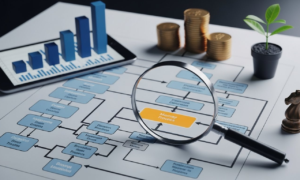The convergence of 5G technology with the Industrial Internet of Things (IIoT) marks the dawn of a new era in industrial automation. Over the past decade, IIoT has enabled companies to make intelligent use of data generated by connected devices—driving efficiency, reducing operational costs, and enhancing predictive maintenance capabilities. But with existing network limitations, the true potential of IIoT is yet to be fully realized. This is where 5G steps in.
5G is not just about faster internet—it’s the key to unlocking greater business value through a more connected, responsive, and intelligent industrial ecosystem. The economic impact of 5G on industrial operations cannot be overstated, as it promises to improve productivity, reduce costs, and enable new revenue streams. A report by Ericsson estimates that by 2030, 5G could unlock up to $700 billion in cumulative revenue potential across industries globally. As industries increasingly rely on real-time data, 5G’s low latency, enhanced connectivity, and improved bandwidth open avenues that were previously out of reach for the industrial world.
“5G has the power to eliminate the latency barriers holding IIoT back,” says Sharath Baddam, a recognized leader and industry expert in IoT and industrial automation. “It transforms the speed and scale at which companies can operate, pushing the boundaries of what’s possible.”
From Automation to Autonomy: 5G’s Impact on Industrial Operations
While 4G networks have been instrumental in the growth of automation, their limitations have held back further developments, particularly in areas requiring real-time responsiveness. This includes robotics, autonomous systems, and remote-controlled machinery.
5G changes the game. It enables near-instantaneous communication between machines, meaning tasks like real-time adjustments in autonomous robots, precise quality control, and predictive maintenance will become faster and more reliable. This shift will move industries away from merely automating tasks to creating autonomous systems that can adapt and respond in real time.
Case in point: Ericsson’s 5G-enabled “smart factory” in Texas, which uses automated guided vehicles (AGVs) and IoT sensors to optimize manufacturing processes in real-time. The factory has reported a significant reduction in unplanned downtime and a increase in overall efficiency since implementing 5G solutions.
“Companies are moving from monitoring systems to autonomous systems, and 5G is the infrastructure that makes this transition seamless,” Sharath notes.
Revolutionizing Supply Chains with 5G
Supply chain resilience has been a key focus for businesses in recent years, especially in the wake of global disruptions. 5G’s potential to reshape global supply chains offers companies a competitive edge by enhancing transparency, reducing costs, and improving efficiency. With 5G, real-time monitoring of shipments, automated inventory management, and data-driven decision-making will reach new heights.
In logistics, 5G networks enable faster communication between warehouses, transport fleets, and distribution centers. Data that used to take hours to process will now be managed in milliseconds, providing supply chain managers with real-time updates. This level of transparency and responsiveness is critical in preventing bottlenecks and optimizing supply chain performance. According to a study by ABI Research, 5G will cut supply chain costs by up to 50% in industries like manufacturing and retail by 2030.
“5G allows for more granular tracking, meaning businesses can identify bottlenecks and inefficiencies on the fly. This level of insight wasn’t possible before,” Sharath emphasizes. For industries reliant on global logistics, this level of real-time oversight is invaluable.
For example, in the food and pharmaceutical sectors, 5G-enabled IoT devices can monitor environmental conditions in real-time, ensuring that products are transported at optimal conditions throughout the supply chain. If any issues arise, companies can respond instantly, minimizing losses. The increased visibility helps businesses meet stringent compliance requirements and avoid spoilage or contamination.
Pushing the Boundaries of Predictive Maintenance
Predictive maintenance—the ability to foresee equipment failure and address it before it happens—has been one of the hallmark benefits of IIoT, leading to significant cost savings for companies by minimizing downtime and extending equipment lifespan. But current network limitations have restricted its full potential. The vast amount of data generated by sensors monitoring machines in real-time requires ultra-reliable and low-latency connectivity. That’s where 5G steps in.
With 5G, businesses can gather real-time data from a higher number of machines and processes simultaneously, enabling them to make proactive decisions, optimize resource allocation, and ultimately improve their bottom line. This leads to more accurate predictions, faster responses to equipment malfunctions, and the ability to perform predictive maintenance at scale. According to McKinsey, companies using predictive maintenance powered by advanced technologies like 5G can reduce maintenance costs by up to 40% and cut machine downtime by half.
Sharath elaborates, “The future of predictive maintenance will be shaped by 5G. The reliability of the connections and the sheer volume of data that can be processed instantly will transform how industries approach equipment monitoring.”
Supporting Sustainable Operations
5G also has a significant role to play in the drive toward more sustainable industrial practices. IIoT systems, powered by 5G, can monitor energy consumption across factories, enabling businesses to optimize their energy usage. Sensors can track real-time data on machine efficiency, water usage, and emissions, ensuring that processes are fine-tuned for both efficiency and environmental sustainability.
This opens the door for industries to meet sustainability goals, whether by reducing energy waste, optimizing resource usage, or even tapping into new green business opportunities—ultimately improving both environmental and financial performance. According to a study by the GSMA, industries leveraging 5G-enabled IoT solutions could reduce their carbon emissions by up to 50% by 2030.
“5G’s ability to connect more devices with less energy and bandwidth opens up exciting possibilities for greener, more efficient industrial practices,” Sharath highlights.
5G in Action: Real-World Use Cases
- Smart Manufacturing: Factories like the Bosch plant in Germany have started using 5G to optimize real-time data processing from connected devices and robotics. Tasks like quality inspection and dynamic production lines, where adjustments are made based on real-time feedback, are already showing improved efficiency.
- Remote Monitoring in Energy: Energy providers such as ABB are utilizing 5G to remotely monitor and manage infrastructure across large distances, ensuring that smart grids and renewable energy sources are integrated seamlessly into national energy grids.
- Augmented Reality in Maintenance: Using 5G-enabled augmented reality (AR) systems, companies like Shell are equipping technicians to carry out maintenance tasks with live data overlays, reducing errors and improving safety in complex environments like oil rigs or factories.
The Road Ahead: Challenges and Opportunities
Of course, as with any transformative technology, the adoption of 5G faces several hurdles. The infrastructure rollout for 5G is still in its early stages, and businesses must carefully plan their transitions. Furthermore, the cost of upgrading equipment to 5G-compatible systems may pose financial challenges, especially for smaller companies.
There’s also the question of security. With 5G enabling more device connections than ever, industries must develop robust cybersecurity measures to protect their networks from potential breaches.
Sharath advises, “Businesses need to view 5G not just as a speed upgrade but as a foundational shift in how they operate, one that provides a significant opportunity for cost reduction, operational efficiency, and enhanced competitiveness. Preparing for the security and infrastructure challenges is just as important as leveraging the opportunities.”
Conclusion: 5G and the Future of IIoT
As 5G networks continue to expand, industries that rely on IIoT will see transformative changes in how they operate. Whether it’s creating autonomous systems, optimizing supply chains, or reducing environmental impact, 5G has the potential to unlock unprecedented levels of efficiency and innovation.
“5G is more than just a network upgrade—it’s the backbone of Industry 4.0,” Sharath concludes. “As industries embrace this technology, we’ll see smarter, faster, and more efficient systems across the board, driving industrial automation to new heights.”


































